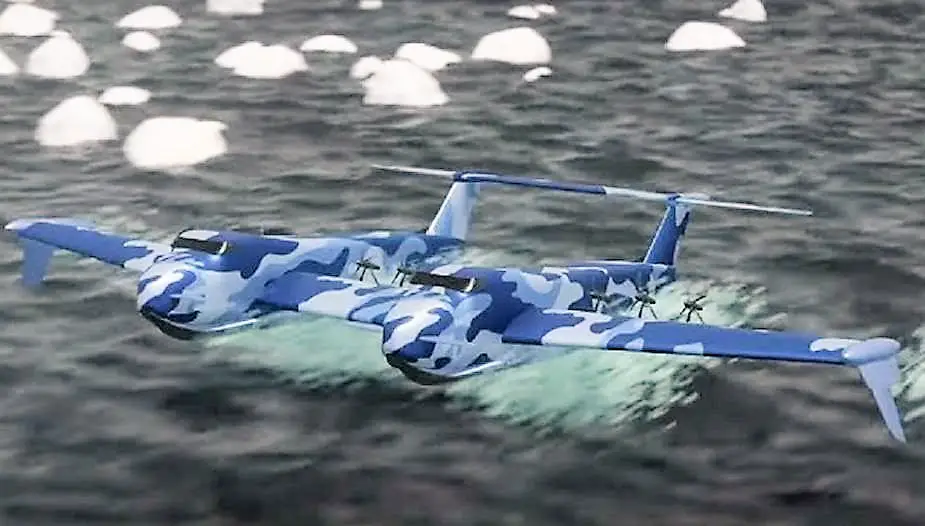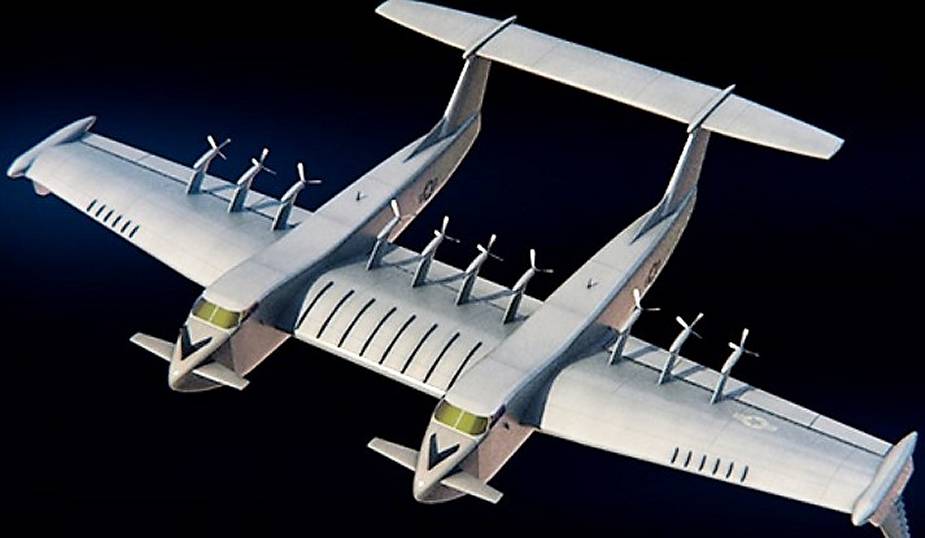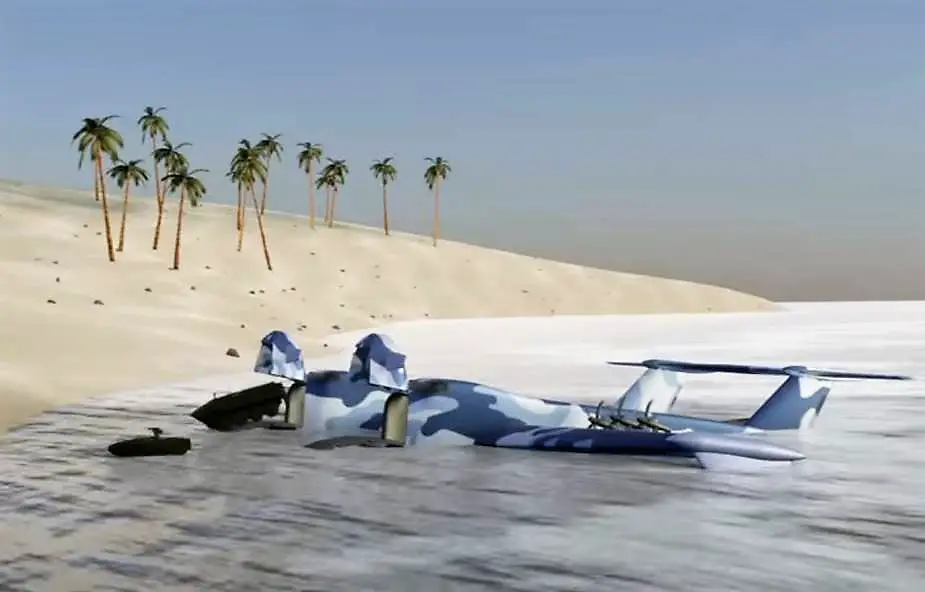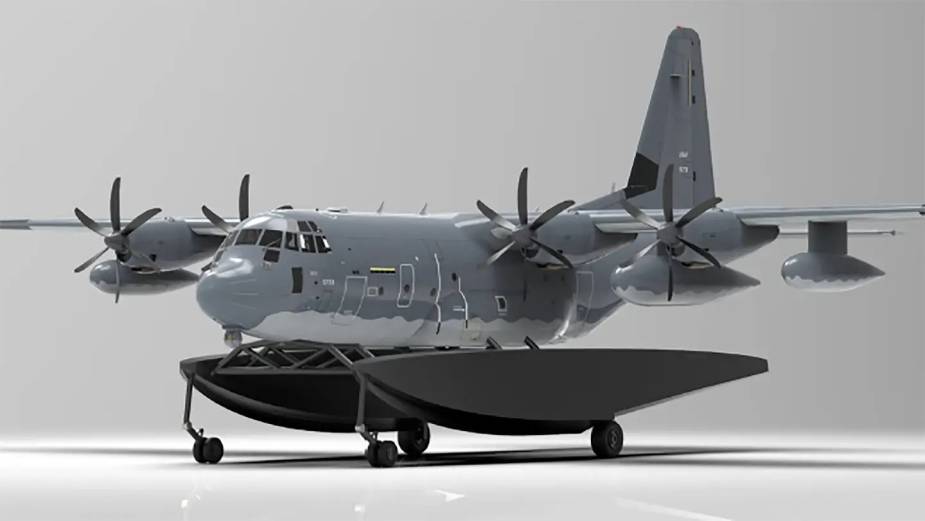In August 2021, DARPA, the Pentagon's agency dedicated to innovation, published a request for information from the industry in order to design a "new class of vehicle" likely to overcome the "key operational limitations of traditional air and sea transport platforms”, Laurent Lagneau reports in Opex360. This was to support a project to develop “new seaplanes and ground effect vehicles, otherwise known as “Ekranoplan”. The objective was then to imagine a device that could carry a payload of 100 tons while having a flight capacity "extended out of ground effect to avoid obstacles" as well as to fly over rough seas.
Follow Air Recognition on Google News at this link
 Concept of one of the two DARPA’s Liberty Flyer shapes, with forward-facing engines (Picture source: U.S. DARPA)
Concept of one of the two DARPA’s Liberty Flyer shapes, with forward-facing engines (Picture source: U.S. DARPA)
The missions of this aircraft were not to be limited to transport alone: DARPA also mentioned possible uses within the framework of the EBAO (Expeditionary Advanced Base Operations) concept and that of DMO – Distributed Maritime Operations. The concept was also to encompass search and rescue, as well as landing during amphibious operations. As reported by Thomas Newdick in The Drive, the Pentagon’s latest vision for a flying transport that is able to operate from water employs the ekranoplan, or wing-in-ground (WIG) effect principle, as used by a class of vehicle that sits somewhere between a boat and a plane. Ekranoplans have so far found only very limited military usage, notably in the former Soviet Union, and it would mark a truly innovative departure if adopted by the U.S. armed forces.
The U.S. Defense Advanced Research Projects Agency, or DARPA, has launched its Liberty Lifter project that aims to create a long-range, low-cost X-plane using the ekranoplan concept. The agency wants the craft to demonstrate seaborne strategic and tactical lift and says that the project should “demonstrate a leap in operational logistics capabilities”. In a media release, DARPA explains: “The envisioned plane will combine fast and flexible strategic lift of very large, heavy loads with the ability to take off/land in the water. Its structure will enable both highly controlled flight close to turbulent water surfaces and sustained flight at mid-altitudes. In addition, the plane will be built with a low-cost design and construction philosophy”.
 Concept of one f the two DARPA’s Liberty Flyer shapes, with pusher engines (Picture source: U.S. DARPA)
Concept of one f the two DARPA’s Liberty Flyer shapes, with pusher engines (Picture source: U.S. DARPA)
Currently, the program is in its initial phase, which involves defining “the unique seaplane’s range, payloads, and other parameters,” according to Alexander Walan, a program manager in DARPA’s Tactical Technology Office. As described by Thomas Newdick, this design uses a straight wing, apparently equipped with various high-life devices, to marry two box-like fuselages, each of which appears to have a cockpit, and which has small canard foreplanes; one version also features a vertical fin on each nose, the purpose of which is not immediately clear. The powerplant is depicted as ten propeller units mounted along the wing. Furthermore, one concept shows these propellers in a pusher configuration, while another has them facing forwards. One important aspect is the cargo unloading process which is achieved by an upward-opening nose door, allowing vehicles to be driven straight up onto the beach from the water’s edge.
The fact that the Liberty Lifter should be able to operate not only by skimming over the surface of the water but also at “mid-altitudes,” of up to 10,000 feet, indicates that the craft will actually be a hybrid, combining the key advantages of an ekranoplan with the superior performance attributes and flexibility of a conventional fixed-winged aircraft. Like an ekranoplan, the Liberty Lifter concept is still able to operate independent of runways and move low over water when required but can then ‘flex’ to the kind of higher-altitude, more agile flight that would be required to avoid larger obstacles as well being able to move loads even faster and more efficiently over greater distances.
 Screenshot of DARPA’s video showing a Liberty Flyer disembarking armored vehicles (Picture source: U.S. DARPA)
Screenshot of DARPA’s video showing a Liberty Flyer disembarking armored vehicles (Picture source: U.S. DARPA)
One of the main challenges DARPA says it will address in the Liberty Lifter program is how to operate in turbulent sea states by creating high-lift abilities at low speeds to reduce wave impact load during takeoff/landing, and innovative design solutions to absorb wave forces. Advanced sensors and control schemes will be developed to avoid large waves and to handle aero/hydrodynamic interactions during the takeoff and landing procedures.
This meshing of different technologies is also mirrored in the fact that DARPA sees the Liberty Lifter as expanding not only upon existing transport aircraft but also cargo vessels, Thomas Newdick reports. Not only will the Liberty Lifter be runway-independent, but it’s planned to have a much-reduced requirement for land-based maintenance, being able “to operate at sea for weeks at a time.”
The U.S. Special Operations Command (SOCOM) already announced the MC-130J Amphibious Capability, or MAC, essentially an amphibious C-130 Hercules variant to operate from littoral areas in support of special operations forces. This kind of transport would answer some of the same questions as the Liberty Lifter, but DARPA is clearly thinking already about more radical approaches to meeting this broad requirement. If, in the future, the Liberty Lifter project does lead to some kind of production aircraft, DARPA says that it will “prioritize low-cost, easy-to-fabricate designs over exquisite, low-weight concepts.” Using more affordable materials should mean that such an aircraft can be purchased in large quantities, Thomas Newdick quotes DARPA saying.
 Concept of Lockheed Martin MC-130J Amphibious Capability, or MAC (Picture source: USSOC)
Concept of Lockheed Martin MC-130J Amphibious Capability, or MAC (Picture source: USSOC)
















